Candied Orange Peel
This post may contain affiliate links. See my disclosure policy.
Making your own candied orange peel and candied lemon peel is super easy and the difference between homemade and store-bought is absolutely mind-blowing! Leave the store-bought stuff on the shelf because nothing, and I mean NOTHING compares to homemade! This candied orange peel recipe can be used to make any variety of candied citrus peel, including orange, lemon, lime, and grapefruit.

Why You Should Make Candied Orange Peel
If you’ve never made your own candied orange peel get ready to be absolutely dazzled!
Today we’re going to make delicious use of a portion of the citrus fruit you may normally discard by making candied citrus peels. Think of these delightful sweet treats like citrus flavor on steroids!
While candied orange and candied lemon are the the most commonly used, candied grapefruit and lime also have a delicious place in the mix and I’m going to demonstrate the process using those as well.
There are a few reasons you should make your own candied peel: 1) The store-bought stuff is generally not organic and citrus fruits are highly sprayed with pesticides and fungicides. 2) It’s made with a lot of chemicals. 3) It’s not fresh. 4) Most of it tastes bad. Like really bad. I regularly have readers request recommendations for good brands of candied citrus and the best recommendation that I can offer is to make your own! Because once you do and taste the difference, you’ll never buy it again.
The good news is, it is SO easy to make your own! And it keeps for a long time, especially if you freeze it. The flavor is 100% better than store-bought and will bring your baked goods to life.

How to Use Candied Orange Peel
There are so many delicious ways you can use candied orange peel and any candied citrus peel variety, whether orange, lemon, lime or grapefruit. (Be sure to also try my Candied Ginger). Here just are a few ideas:
- Baked in pies, cakes, muffins and cupcakes (see my Stollen, Figgy Pudding, Lebkuchen, Dundee Cake, Bara Brith, Barmbrack, Eccles Cakes, and Panettone)
- Added to Scottish Shortbread, cookies, and scones
- Sprinkled over ice cream or Homemade Greek Yogurt
- Added to Healthy Homemade Granola
- As garnish for citrus-flavored drinks
- Use in traditional English Mincemeat
- Baked into waffles and pancakes (see my Whole Wheat Sourdough Waffles)
- Dipped in chocolate for an elegant sweet treat (dip candied orange peels in chocolate to make orangettes, a classic French confection)

Candied Orange Peel Recipe
Let’s get started!
*NOTE: The process is the same for making any kind of candied citrus peel.
Select the best citrus fruits possible and give them a thorough scrubbing and washing. We’re not sticklers about buying all of our produce organic, but we do stick to organic for certain items that are highly sprayed and/or waxed. And in the case of citrus fruits, if I’m using the peels for zesting or candying, I use and recommend organic.
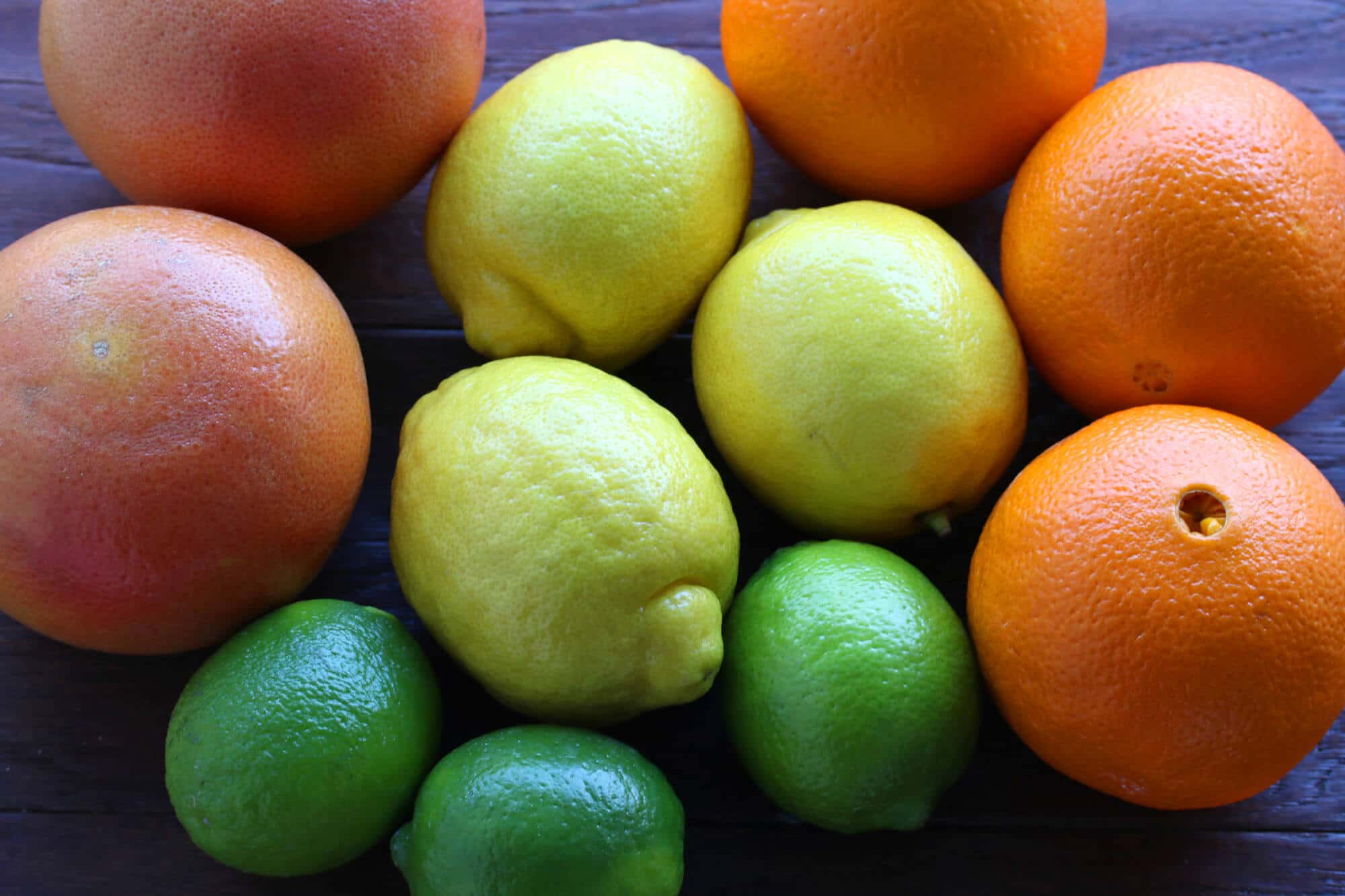
Slice both ends of the orange. Cut the peel on each each into 4 or more vertical segments, depending on the size of the fruit. Peel off each segment of rind.
Note: You can remove a some of the white pith, though not necessary. The white pith has a bitter flavor, so keep that in mind, but also keep in mind that the thinner your peels the harder/more leathery they will be. The purpose for blanching the peels (boiling in water and discarding the water) is to eliminate some of the bitterness. If leaving the pith on you can repeat the blanching procedure 2 or 3 times to reduce the bitterness.
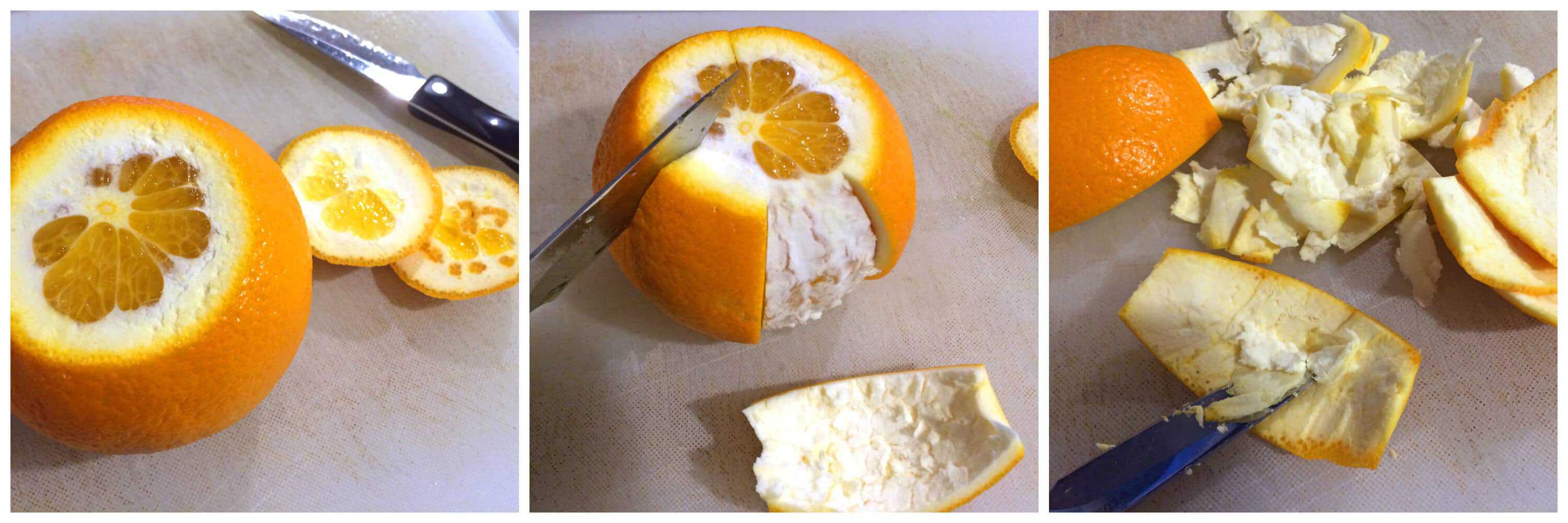
The process is the same for any citrus fruit. Candied grapefruit peel, candied lemon peel, candied lime peel, candied mandarin or clementine peel…they’re all delicious!
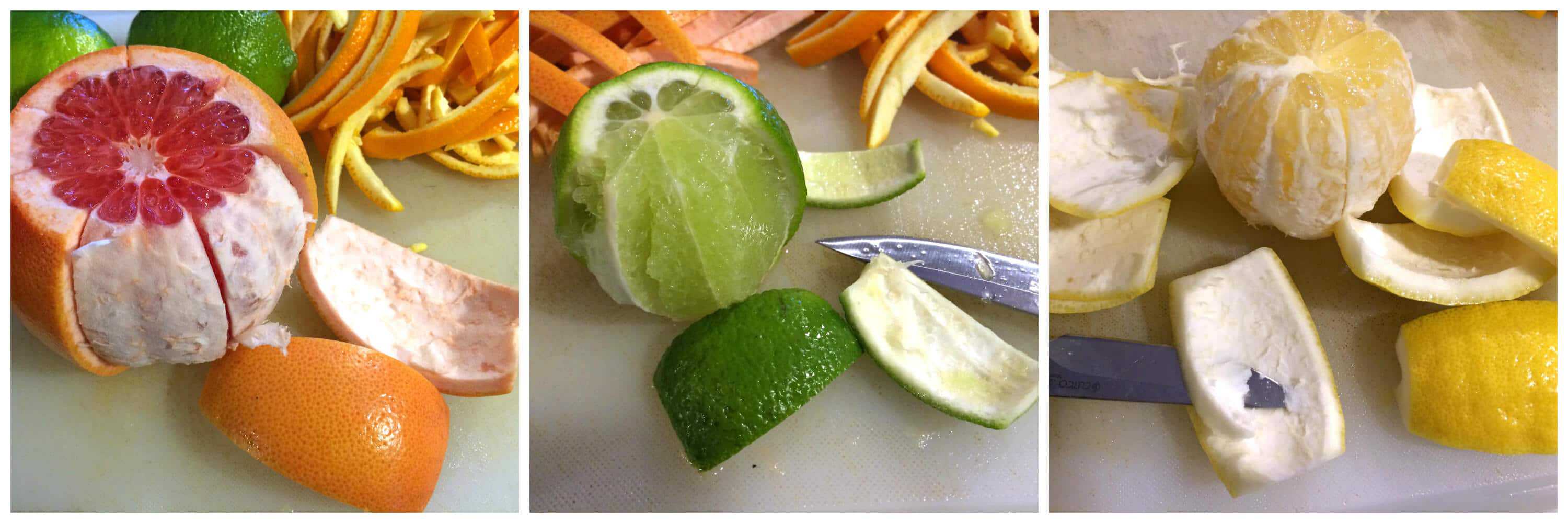
Slice the peels into 1/4 inch wide strips.
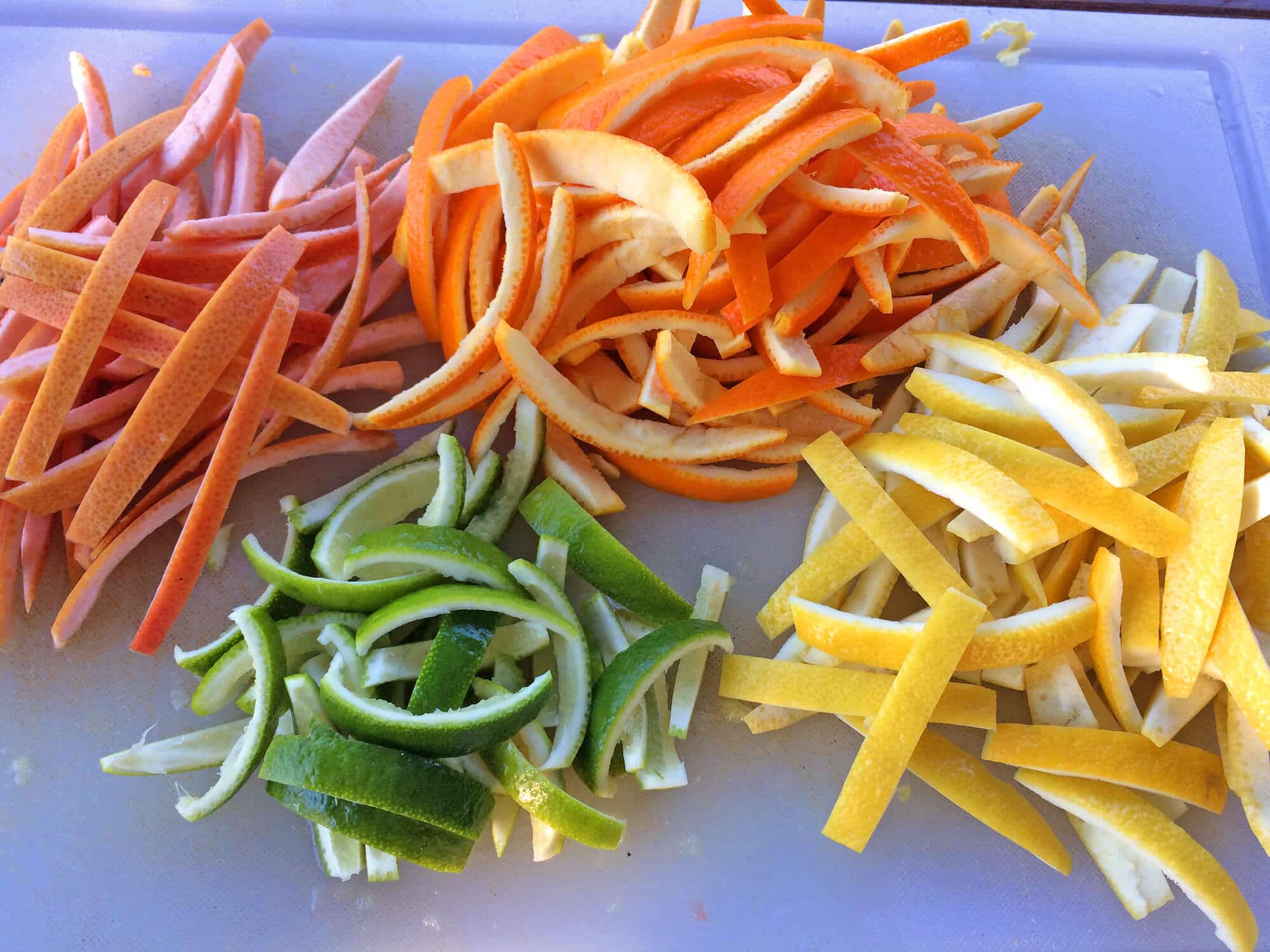
Keep the peeled citrus for eating, cooking or juicing.
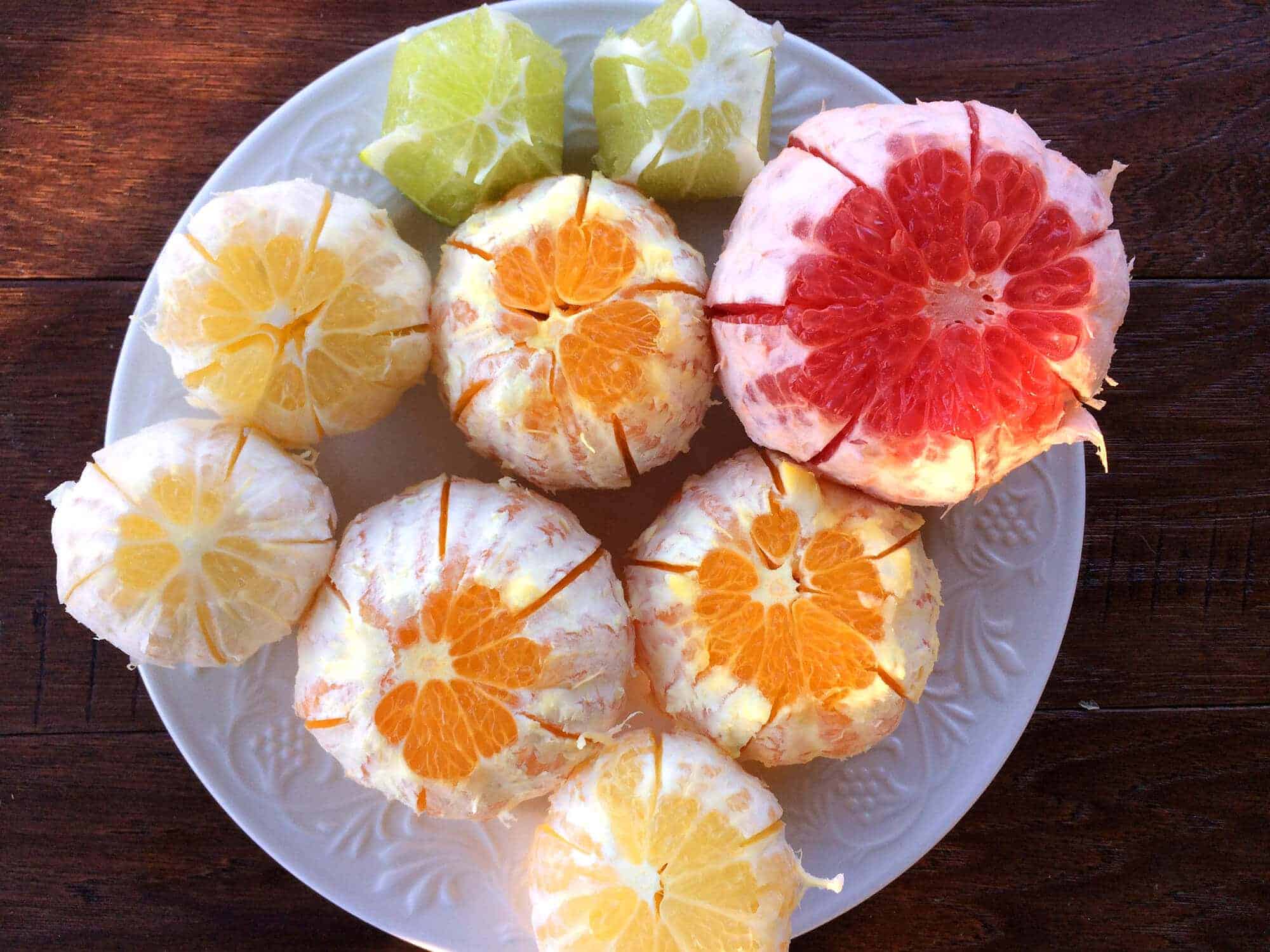
Boil the peels in water in a pot for 15 minutes. Drain the peels in a colander, rinse and then drain again. Discard the water from the pot.
**Note: To further reduce the bitter flavor repeat this step.
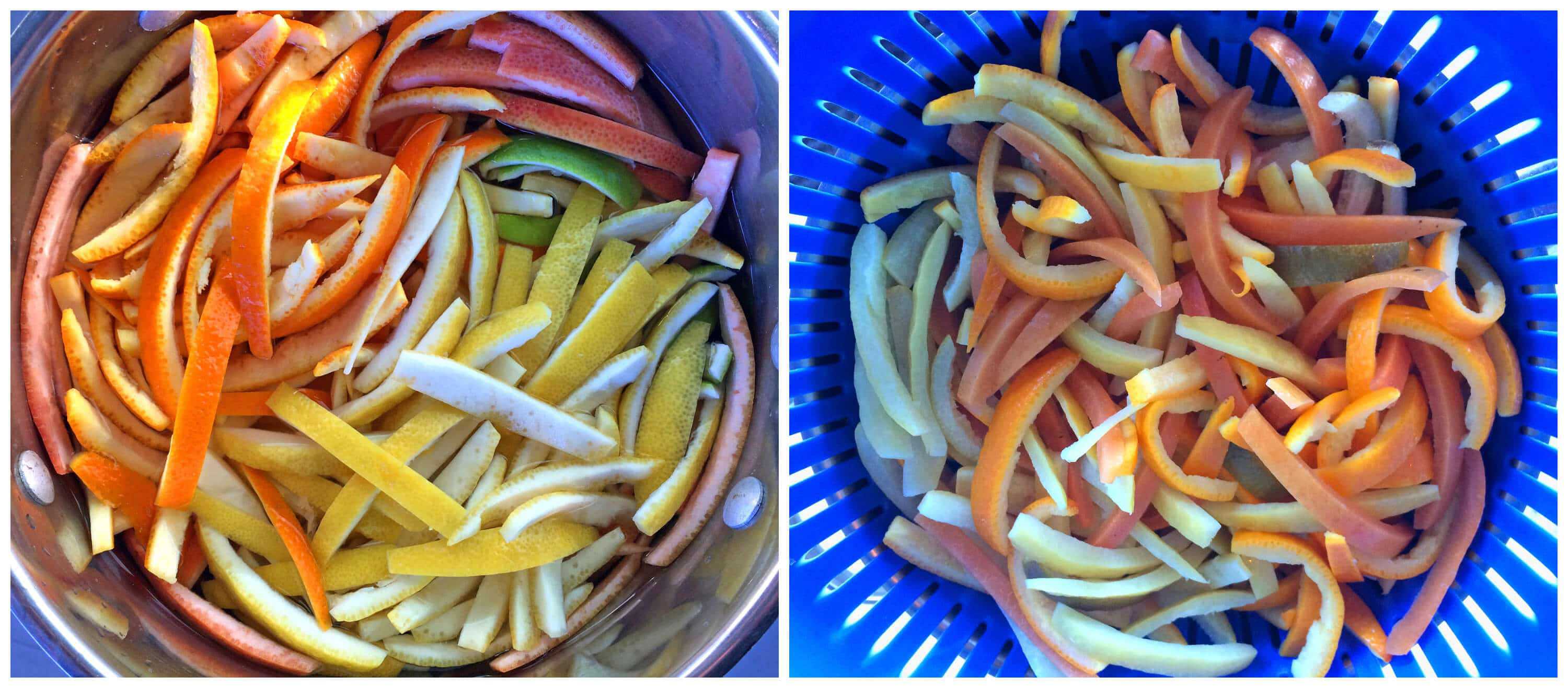
Add the sugar and fresh water to the pot and bring it to a boil. Boil it for a couple of minutes until the sugar is dissolved.
Add the citrus peels, reduce the heat and simmer for about 45-60 minutes, stirring occasionally, until the peels become translucent and the liquid becomes lightly syrupy.
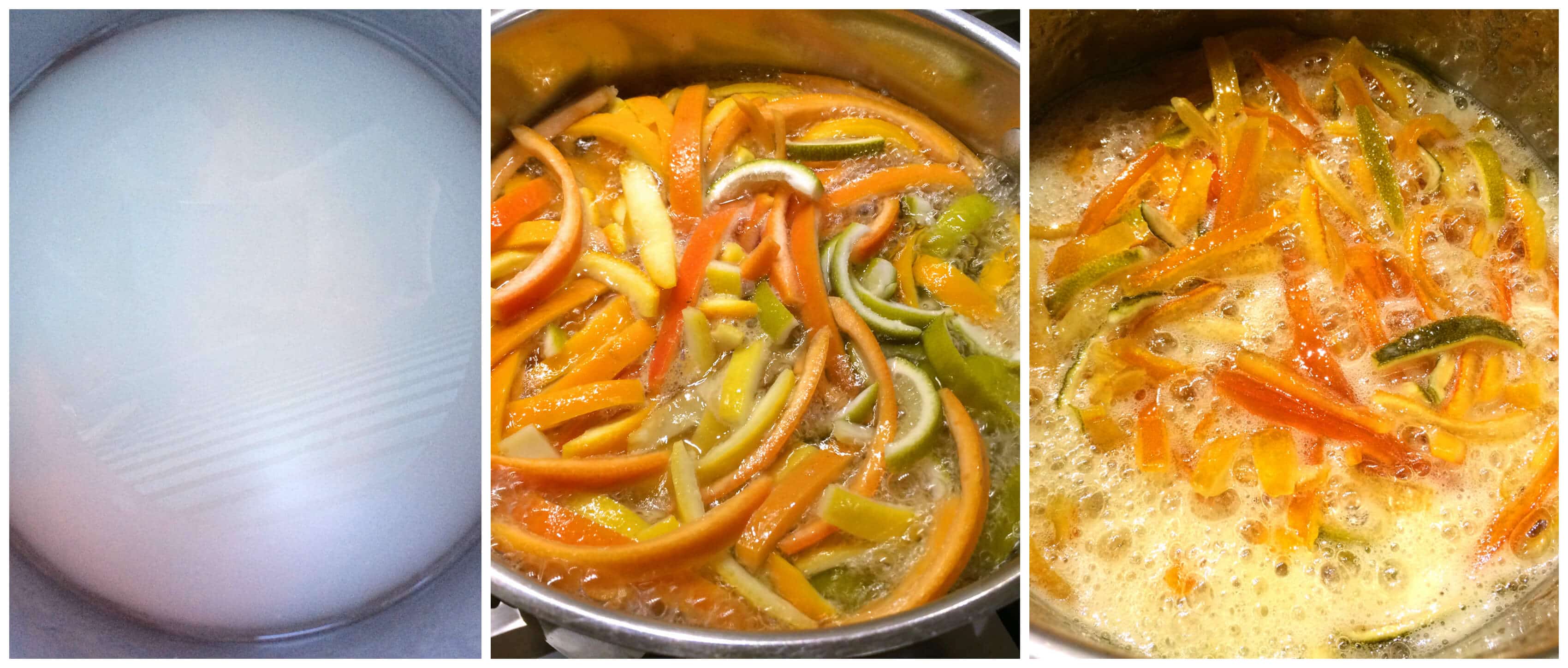
Use a slotted spoon to remove a few of the peels at a time and let the excess syrup drip off for a few seconds. Place the hot, wet peels in the bowl of sugar and toss to coat. If you’re making a large batch it’s easiest to place the sugar in a ziplock bag and shake the peels in it.
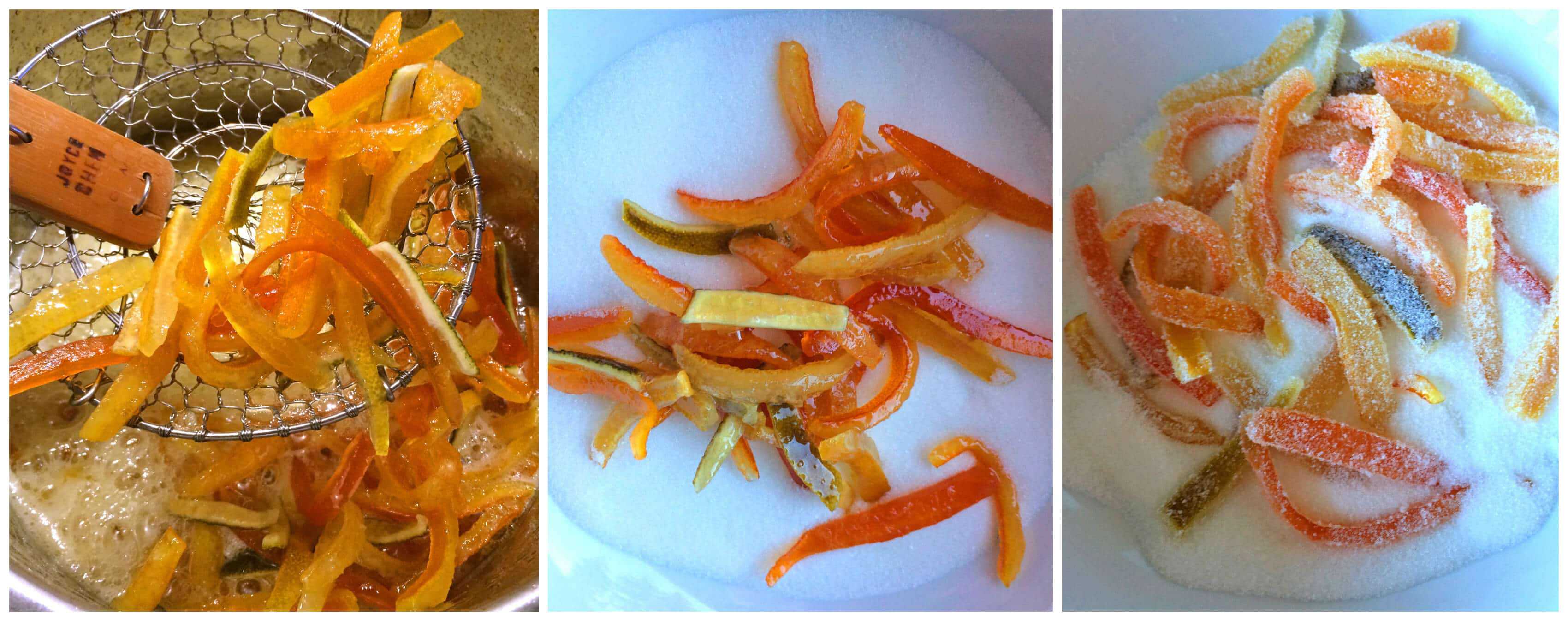
Spread the candied citrus peels out on a wire rack to cool and dry completely, 1-2 days.
Stored in an airtight container in a cool, dry place, the candied citrus peel will keep for at least a month. They’ll keep even longer in the fridge and for a few months frozen. (I usually keep them in a ziplock bag in the freezer and then conveniently grab whatever I need.)
Note: If you find your candied citrus peel gets hard after a while don’t worry – they will soften up beautifully as they bake in whatever recipe you add them to!
Tip: To keep the candied peels even softer you can limit the drying time, skip the final sugar coating step and put the peels in a ziplock bag and either refrigerate or freeze them.

Orange Simple Syrup
Finally, DON’T DISCARD THE CITRUS SYRUP!
This is a wonderful citrus-flavored simple syrup to add to your drinks for a wonderful kick of citrus flavor!
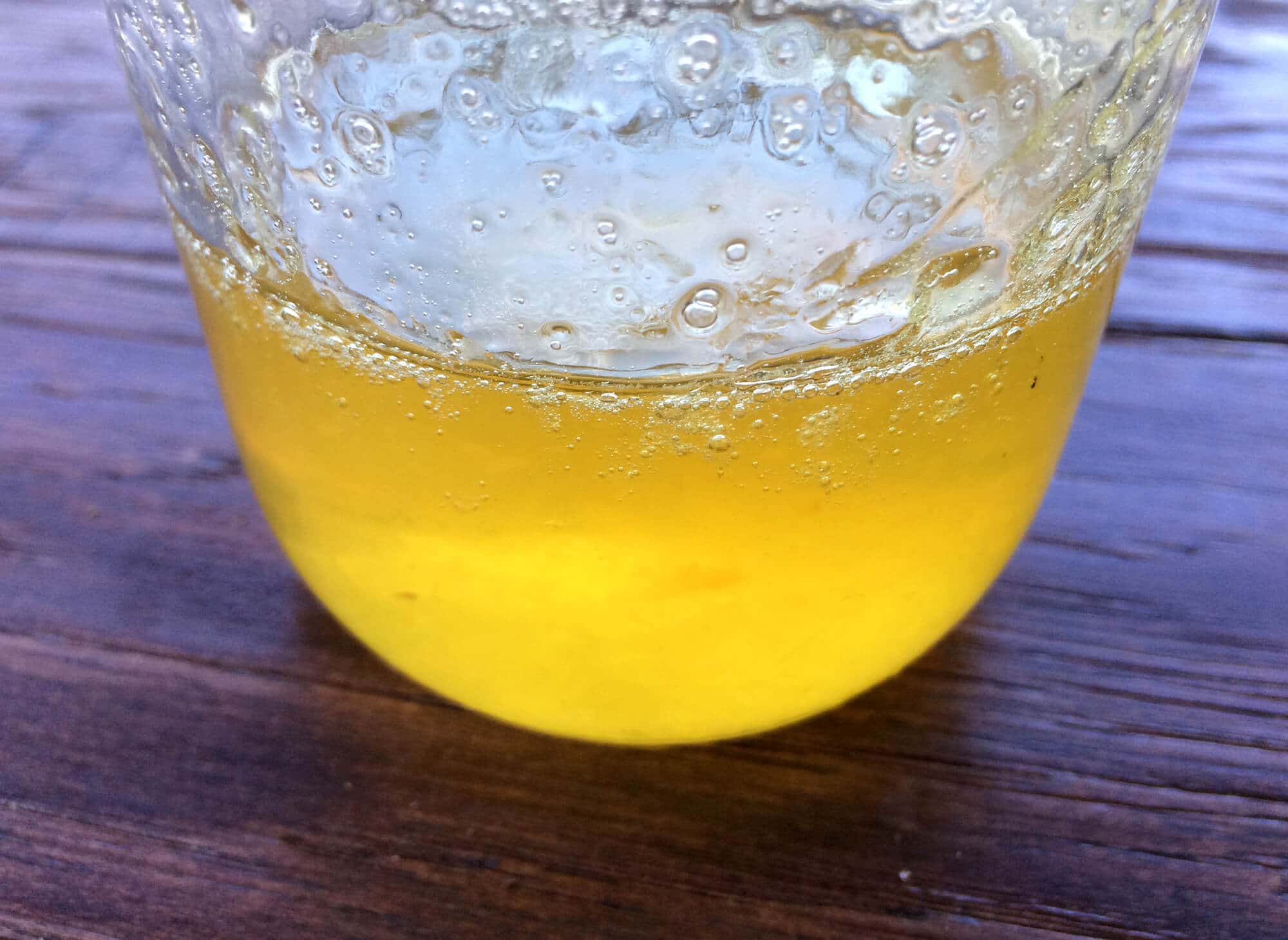
Enjoy!

Save This Recipe

Candied Orange Peel
Ingredients
- 3 large oranges (can also use the equivalent of lemons, grapefruits, limes, or citrus of your choice, thoroughly washed and scrubbed; organic is recommended)
- 2 cups granulated sugar
- 1 cup water
- Fine granulated sugar for coating
Instructions
- Slice both ends of the citrus fruits. Cut the peel on each each into 4 or more vertical segments, depending on the size of the fruit. Peel off each segment of rind. (You can remove a little of the white pith, though not necessary. The pith is bitter but the blanching process below will help reduce the bitterness. Note that if you remove the white pith, the thinner the peels are the harder and more leathery they will be when they’re candied.) Slice the peels into 1/4 inch wide strips. (Keep the peeled citrus for eating, cooking, juicing, etc)
- Boil the peels in a pot of water for 15 minutes. Drain the peels in a colander, rinse and then drain again. Discard the water from the pot.Repeat this process one or two more times to reduce the bitter flavor.
- Add the 1 cup of fresh water and the sugar to the pot and bring it to a boil. Boil it for a couple of minutes until the sugar is dissolved. Add the citrus peels, reduce the heat to low and simmer for 45-60 minutes, stirring occasionally, until the peels become translucent and the syrup becomes lightly syrupy (on a candy thermometer this will be be approximately soft ball stage).
- Use a slotted spoon to remove a few of the peels at a time and let the excess syrup drip off for a few seconds. Place the hot, wet peels in a bowl of sugar or a ziplock bag with sugar in it and toss/shake to coat.Spread the candied citrus peels out on a wire rack to cool and dry completely, 1-2 days. *Note: Tossing them in sugar and letting them dry is only necessary if you're storing them at room temp for an extended period of time. They can be used immediately in any recipe that calls for them. And any leftovers can be put in a freezer bag/container and frozen as is until the next time you need them.Stored in an airtight container in a cool, dry place, the candied citrus peel will keep for at least a month. They'll keep even longer in the fridge and can be frozen for several months.Yields roughly 8 ounces of candied citrus peel depending on peel thickness.
Notes
*If you’d like to make more candied citrus peel, simply increase the amount of water and sugar by the same 1:2 ratio.
Nutrition
Originally published on The Daring Gourmet January 9, 2017



















Wonderful recipe I actually let them simmer for longer because I like to just eat them as a treat. I remember my grandmother making these, I didn’t however toss them in sugar I just laid them on the rack and lightly sprinkled them. Absolutely delicious and no bitter taste as long as you simmer them until the pith is translucent thank you for a wonderful recipe that’s easy to follow.
I’m so glad you enjoyed them, Michelle, and really appreciate the feedback, thank you!
Thank you for this recipe. I had read others and was scared off by the amount of times they were re sugared it looked so complicated I couldnt be bothered to try it. This recipe looks great and it might sound obvious but the explanation about cutting the peel off the fruit is also very good. Season’s greetings to all the folks trying this and to your goodself for sharing!!
Definitely don’t be scared off, Amanda, it may initially seem complicated but it’s very easy – and you’ll be very glad you did it! :)
I’d like to know how much this recipe yields. I followed this link from the Christmas Stollen recipe which requires “3 oz.” of both lemon and orange candied peel. Your peel recipe doesn’t mention an amount by weight or volume for any of the peel. I’m guessing that since you have nutritional information posted for the final results, you must know how much is produced.
Thanks!
Hi Jonni, this yields the candied peels of 3 oranges and 4 lemons and the final weight will vary depending on the size of the fruits.
Is the entire 2 cups of sugar used in step #3?. If so, where does the sugar in the bowl come from? How much?
Hi Bob, yes that’s correct. The sugar at the end is for putting in a bowl to dip/roll the candied peel in and you’ll just use however much you need for that. Start with less and if you need more you can add more.
They are delish but I am on day 2 and they are still very wet any tips ??
Hi Kristin, either the syrup didn’t get up to the correct temperature or the environment they’re drying in is very humid. At this point you can either dry them in a food dehydrator or in the oven set to the lowest temperature (you may need to crack the oven door open) and check periodically until they’re done.
This recipe turned out great. But in the sugar tossing process, some of the sugar started to get overly thick on the peels so I later had to take some of them off so I wasn’t crunching on straight sugar. but overall great recipe
Thanks, Tori! I’ll often just skip the sugar coating altogether because I just freeze the candied peel – it keeps a very long time in the freezer and I can conveniently get some as I need it.
What is the yield of this recipe? i need it for a couple recipes of cake.
Can you use Mandarin oranges for the candied peel? They seem to have a stronger flavour.
Hi Reg, sure, you can use any citrus peels of your choice.
I live in South East Asia and the humidity is very high, would it be possible to dry the peel in a dehydrator? (I use it for making jerky for my doggies)
Hi Larry, yes, that should be just fine.
I signed up for your newsletter, Kimberly, when I saw your Lebkuchen recipe! Thank you for sharing and show exactly how to do. The only ones I love commercially are the Burg Graf ones but can only get around Thanksgiving. Now I can have any time of the year with your website! Eager to bake and try some of your other goodies!!
Thanks so much for signing up, Allyson! I’m glad you found us and hope you enjoy the recipes you try. Happy Thanksgiving!
Hi Kimberly – I found 2 versions of this recipe one recommends 1 hour cooking time and the other only 20 minutes – any idea which is correct?
Hi Sybille, I recommend closer to 20 minutes for softer, more pliable candied citrus peel. Simmering it longer results in a candied peel that is more enjoyable for eating and/or dipping in chocolate but I’ve found that a softer peel is easier to work with for using in baking.
I find it impossible to get the pith off without destroying the peel. I boiled the peels about 10 minutes, drained and rinsed, and then removed the pith. Sliced right off.
Great tip, Maria. You can also boil and drain the peel a few times to remove the bitterness and then not worry about having to remove the pith at all. With the pith on the finished candied citrus peels will be softer. It’s just all a matter of personal preference.
These turned out perfect! We plan to use them in your stollen recipe next week.
also, I’m making Dominosteine this year for Christmas. Do you think that your recipe for quince paste would work for the “jelly” layer? Thanks in advance.
Wonderful, Jennifer, and I’m excited that you’re making the Stollen! Now that’s a truly awesome idea, incorporating quince jelly into the Dominosteine! Texture-wise I think it should be firm enough. But don’t hate me if it for some reason doesn’t work out for that purpose :) If you give it a try let us know how it goes!
Wow these came out absolutely excellent. Definitely the way to go versus store bought. Thanks for sharing such a great recipe!
Thanks, Arica, I’m so glad they were a success!
Thank you for the very detailed instructions and photos. I had candied yuzu peel i Japan and loved it. Now I can make it—if I can find fresh yuzu!